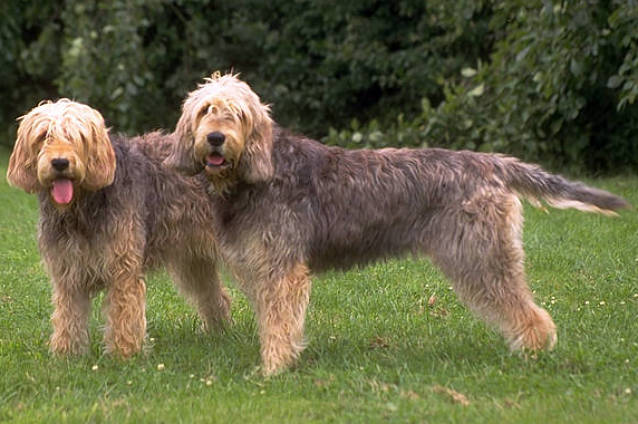Despite his AKC recognition, the Otterhound is one of the rarest dog breeds in the world. These friendly hunting dogs have a unique wire coat which sets them apart from other scenthound breeds – a coat that allowed them to hunt otter in frigid rivers. Despite their general rarity, the breed makes great companions for those owners patient enough to wait for one to become available.
Otterhounds can be versatile enough to succeed in many different activities. Not only are they adept at their specific hunting task, but several members of the breed have become Search and Rescue dogs – a task which makes use of their great senses of smell. Tracking and nosework are two other nose-centric dog sports which Otterhounds are quite successful at. Overall, however, the breed is adaptable to many different activities although growing puppies will need special care to make sure they aren’t over-exercised. Once the joints are fully formed, the dog will be able to engage in more physically demanding tasks.
The Otterhound tends to have a sense of humor and loves to amuse his owner. He is definitely one of the clowns of the hound world! Many Otterhounds do not realize their size and think they are lapdogs – and a 100 pound lapdog is a heavy load! This is not a frantic or anxious dog by nature and, in fact, has a slow and steady way about him. He is not normally in a hurry – unless he is in hunting mode. In spite of his unhurried nature, he is moderately active overall and does require regular exercise, although once back at home after a long walk he will turn into a couch potato. Without mental and physical stimulation he is prone to boredom.
Living with an Otterhound can be a trying experience for those expecting a perfectly clean dog. To start with, these big dogs are fond of digging and covering themselves in mud. Most are not dissuaded by rain and think nothing of taking a joyful run through the yard during a rainstorm – leaving you to clean up after them. Furthermore, their beards are prone to getting wet from the water bowl, or covered in food from the food bowl. They require a brushing every week, nail care, tooth care, and special care of ears. Long ears tend to get dirty easier than other types of ears and must be cleaned regularly. 
When meeting new people, the Otterhound is a social butterfly, often becoming more excited and active. He will eagerly announce the visitor’s arrival (which serves as a great alarm and deterrent), but will quickly make friends afterward. This is not an aggressive breed, nor a natural guard dog. With family (including children), the breed is loyal and equally friendly, without being demanding of attention (although young dogs may inadvertently hurt toddlers or senior citizens because of their size). With other pets, as well as with strange dogs, they are normally happy and social.
Otterhounds are fairly intelligent animals, although not always easy to train. They are great problem solvers and can figure out how to manipulate people into doing their bidding. They must be trained with methods that are fair and without excessive harshness. Sensitive in nature, they tend to shut down with harsh corrections. The breed can be equally stubborn – this combination make them difficult to train for novices. If he doesn’t feel like doing a command he will often pretend to be deaf, and his huge size makes it hard for him not to get his way!
Being bred to hunt, the Otterhound requires a safe yard when he is outside. Otherwise, his nature will take him right off the property in pursuit of game – a prospect that can be very dangerous. This is true for most, if not all, scenthound breeds. Furthermore, Otterhounds were bred to hunt in packs and therefore enjoy living with other dogs. If this isn’t possible, they require a living situation where their owner is frequently at home. They must have a companion, in one way or another, to keep from becoming destructive, bored or outright depressed. Excessive loudness is one common behavior problem seen in Otterhounds without a companion.
Like most scenthounds, the Otterhound has a melodic (read: loud) voice that he enjoys using. This can result in complaints from neighbors. He does best living in a country setting away from direct neighbors, in a situation where he is socialized early and often with other people. The breed matures slowly and needs this socialization to keep him from becoming fearful – and instead nurtures his natural tendency to become social and friendly.
